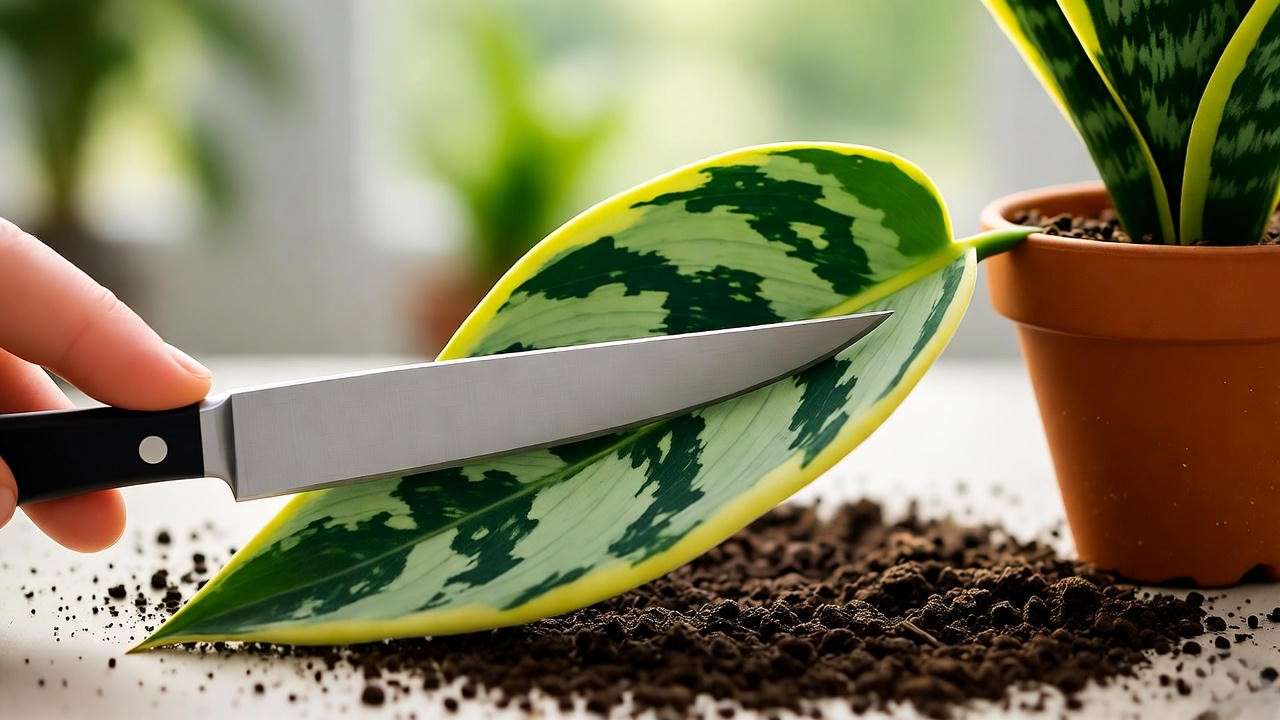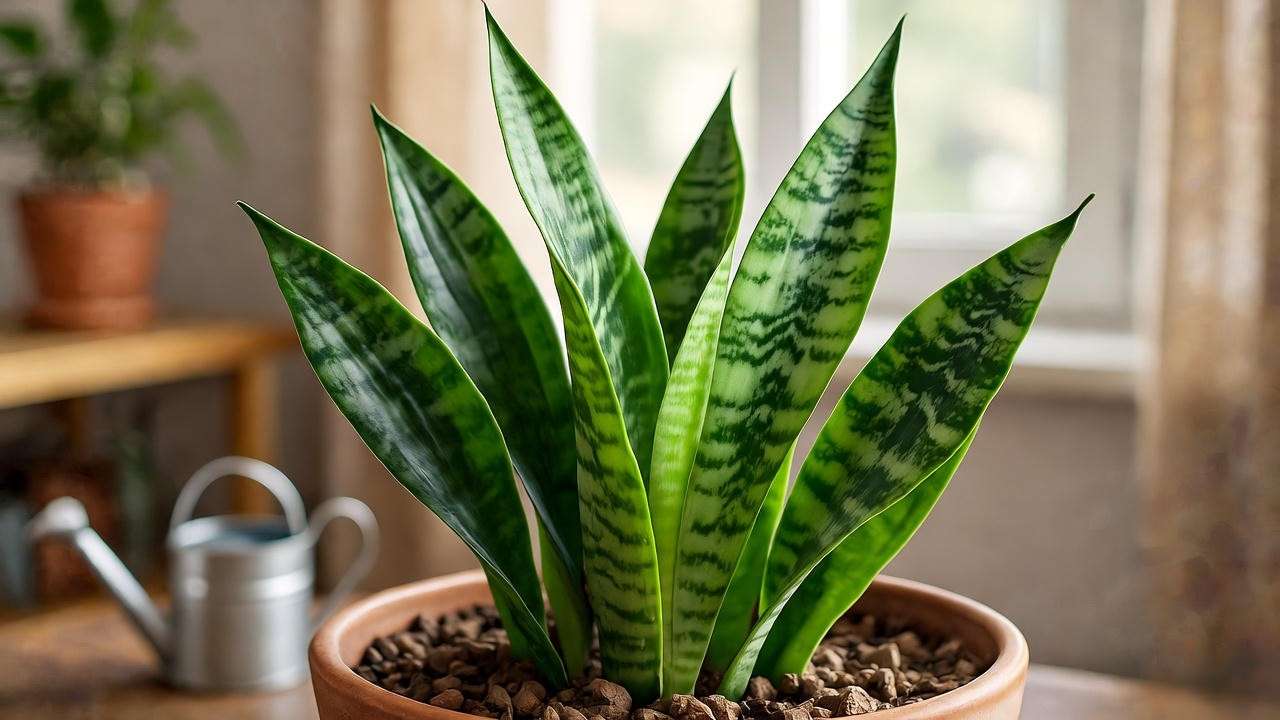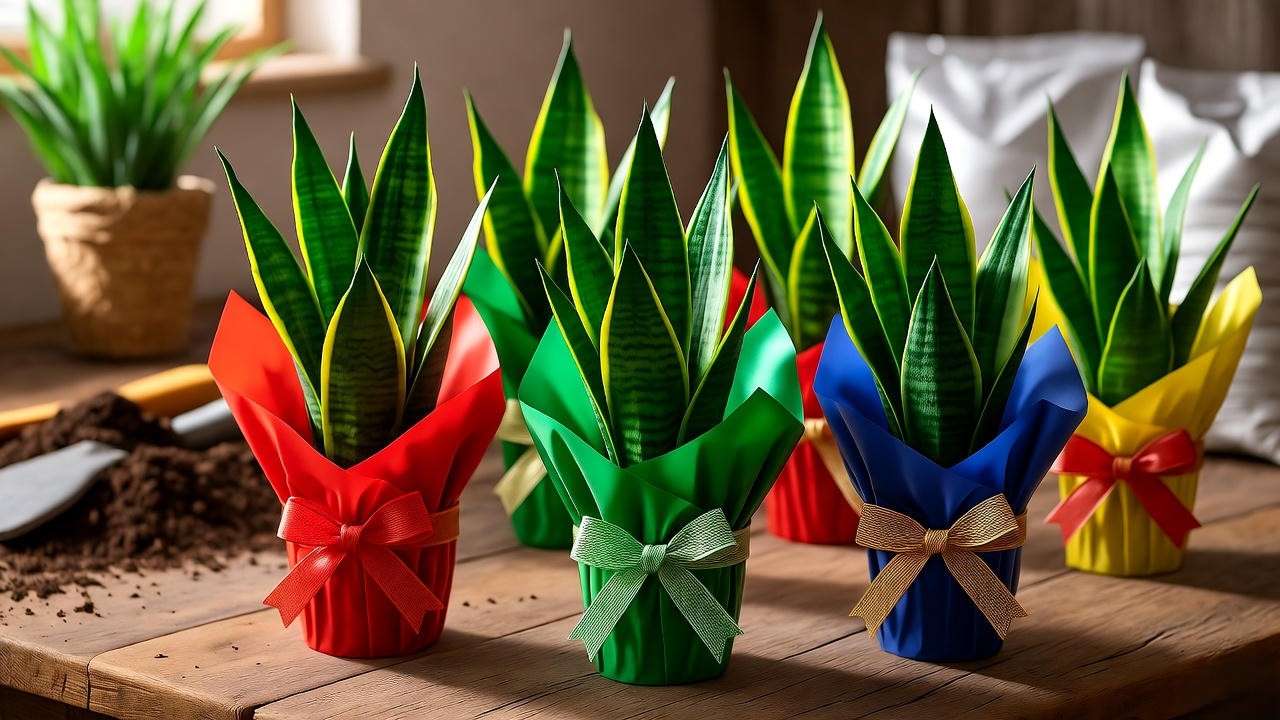Imagine filling your home with lush, vibrant snake plants, their sleek, sword-like leaves purifying the air and adding a touch of modern elegance—all without spending a dime on new plants! Propagating a snake plant is not only a rewarding way to expand your indoor jungle but also an easy, beginner-friendly project that anyone can master. Whether you’re a seasoned plant parent or a newbie looking to propagate a snake plant for the first time, this guide will walk you through every step with expert precision. With over a decade of hands-on experience in horticulture and a passion for sustainable plant care, I’ve distilled the best techniques, insider tips, and common pitfalls to avoid, ensuring your new snake plants thrive. Ready to grow your collection or share the love with friends? Let’s dive in! 🌿
What Is a Snake Plant? 🌿
Overview of Sansevieria (Snake Plant) 🌱
The snake plant, scientifically known as Sansevieria (now reclassified as Dracaena), is a beloved houseplant known for its striking, upright leaves that resemble swords. Often called Mother-in-Law’s Tongue due to its sharp, pointed foliage, this plant comes in various cultivars, from solid green to variegated patterns with yellow or silver stripes. Snake plants are prized for their resilience, thriving in low light, tolerating irregular watering, and even improving indoor air quality by filtering toxins, as noted by NASA’s Clean Air Study.
Why Propagation Is a Game-Changer for Plant Lovers 🌸
Propagating snake plants is a cost-effective way to multiply your collection without buying new ones. It’s also a sustainable practice, reducing waste and encouraging eco-friendly gardening. Plus, propagation lets you share plants with friends or customize your space with these low-maintenance beauties. Whether you’re refreshing an overgrown plant or creating gifts, propagation is a skill every plant enthusiast should master.
Understanding Snake Plant Propagation: The Basics 🌿
What Does Propagation Mean? 🌱
Propagation is the process of creating new plants from an existing one, either by using cuttings, division, or seeds (though seeds are rare for snake plants). Snake plants are ideal for propagation due to their hardy nature and ability to root easily. With the right approach, you can turn one plant into many, each as vibrant as the original.
When Is the Best Time to Propagate a Snake Plant? ⏰
The best time to propagate a snake plant is during spring or early summer when the plant is in its active growth phase. Warmer temperatures and longer daylight hours encourage faster rooting and growth. Look for signs that your plant is ready: healthy, firm leaves, a robust root system, and no signs of stress like yellowing or wilting.
Tools and Materials You’ll Need 🛠️
To propagate a snake plant, gather these essentials:
- Sharp, sterilized scissors or a knife (to prevent disease spread).
- Clean pots with drainage holes.
- Well-draining soil (cactus or succulent mix works best).
- A jar or glass for water propagation (if using this method).
- Optional: Rooting hormone to speed up root development.
- A sunny spot with indirect light.
Expert Tip: Always sterilize your tools with rubbing alcohol to avoid introducing pathogens that could harm your cuttings.
Methods to Propagate a Snake Plant: Step-by-Step Guides 🌿
Method 1: Leaf Cuttings in Soil 🌱
Leaf cuttings in soil are the most popular method for propagating snake plants due to their simplicity and high success rate. Here’s how to do it:
Step-by-Step Process
- Select a Healthy Leaf: Choose a mature, healthy leaf at least 6 inches long from your snake plant. Avoid leaves with damage or discoloration.
- Cut into Sections: Using a sterilized knife, cut the leaf into 2–3-inch sections. Mark or note the bottom end (the part closest to the root) to ensure proper planting.
- Let Cuttings Callus: Place the cuttings in a dry, shaded spot for 1–2 days to allow the cut ends to callus. This prevents rot when planted.
- Plant in Soil: Fill a pot with well-draining soil (a mix of potting soil and perlite is ideal). Insert the bottom end of each cutting about 1 inch deep into the soil.
- Water Sparingly: Lightly water the soil, ensuring it stays slightly moist but not soggy. Overwatering is the leading cause of failure.
- Provide Indirect Light: Place the pot in a spot with bright, indirect light. Avoid direct sunlight, which can scorch the cuttings.
- Be Patient: Roots typically form in 4–8 weeks, with new shoots appearing in 2–3 months.

Pros and Cons
- Pros: Beginner-friendly, requires minimal equipment, high success rate.
- Cons: Slower growth compared to division; variegated leaves may produce solid green plants.
Expert Insight
Variegation (yellow or silver stripes) is often lost when propagating via leaf cuttings because the new plants grow from the leaf’s genetic material, which may not carry the variegation trait. For variegated plants, consider the division method instead.
Method 2: Leaf Cuttings in Water 💧
Water propagation is a fun, visual way to propagate snake plants, letting you watch roots develop. It’s great for beginners who enjoy seeing progress.
Step-by-Step Process
- Cut a Healthy Leaf: As with soil propagation, select a mature, healthy leaf and cut it into 2–3-inch sections.
- Place in Water: Submerge the bottom end of each cutting in a jar of water, ensuring no leaves are underwater to prevent rot.
- Change Water Regularly: Replace the water every 5–7 days to keep it fresh and oxygenated.
- Position in Light: Place the jar in bright, indirect light. A windowsill with filtered light is perfect.
- Monitor Root Growth: Roots should appear in 3–6 weeks. Once they’re 1–2 inches long, transplant the cuttings into well-draining soil.
- Transplant Carefully: Plant the rooted cuttings in soil, water lightly, and continue care as a mature plant.
Pros and Cons
- Pros: Engaging to watch, simple setup, great for small spaces.
- Cons: Higher risk of rot if water isn’t changed regularly; slower to establish in soil.

Common Mistake to Avoid
Avoid overfilling the jar, as submerged leaves can rot. Use a narrow container to keep cuttings upright and only the bottom end in water.
Method 3: Division of Rhizomes 🌿
Division is the fastest way to propagate a snake plant, especially for mature plants with multiple shoots or overcrowded pots. It also preserves variegation.
Step-by-Step Process
- Remove the Plant: Gently take the snake plant out of its pot and shake off excess soil to expose the roots and rhizomes (thick, horizontal stems).
- Identify Divisions: Look for natural separations where rhizomes connect clusters of leaves. Each division should have roots and at least one shoot.
- Separate with Care: Use a sterilized knife to cut through the rhizomes, ensuring each section has roots and leaves.
- Replant Divisions: Plant each division in a pot with fresh, well-draining soil. Press the soil gently around the roots.
- Water and Place: Water lightly and place the pots in bright, indirect light. Avoid overwatering during the first few weeks.
Pros and Cons
- Pros: Faster growth, preserves variegation, ideal for rejuvenating overcrowded plants.
- Cons: Requires a mature plant, slightly more invasive than cuttings.
Expert Tip
Division is perfect for refreshing an older snake plant. It not only creates new plants but also gives the mother plant more space to thrive.
Caring for Your Newly Propagated Snake Plants 🌱
Once you’ve successfully propagated your snake plant, proper care is crucial to ensure your new plants grow strong and healthy. Here’s everything you need to know to nurture your baby snake plants into thriving specimens. 🌿
Watering Needs 💦
Snake plants are drought-tolerant, but newly propagated plants need careful attention to avoid overwatering, which is the most common cause of failure.
- How Often to Water: Water sparingly, allowing the soil to dry out completely between waterings. For cuttings or divisions, this might mean watering every 10–14 days, depending on humidity and light conditions.
- Signs of Overwatering: Yellowing leaves, mushy roots, or a soggy base indicate too much water. If you notice these, reduce watering and ensure proper drainage.
- Expert Tip: Use a moisture meter if you’re unsure about soil dryness, especially for new plant parents. Underwatering is safer than overwatering for snake plants.

Light and Temperature Requirements ☀️
Snake plants are adaptable but thrive under specific conditions that promote healthy growth.
- Ideal Light: Place your propagated plants in bright, indirect light. A north- or east-facing windowsill is perfect. They can tolerate low light, but growth will be slower.
- Avoid Direct Sunlight: Harsh, direct sun can scorch delicate new leaves, especially for cuttings still developing roots.
- Temperature Range: Keep your plants in a warm environment between 60–85°F (15–29°C). Avoid cold drafts or sudden temperature drops, such as near air conditioning vents.
- Pro Insight: If you notice slow growth, try moving the plant to a brighter spot, but ensure the light is filtered to prevent leaf burn.
Soil and Potting Tips 🪴
The right soil and pot setup are critical for preventing root rot and encouraging growth.
- Best Soil Mix: Use a well-draining mix, such as a cactus or succulent potting soil blended with perlite or sand. This ensures excess water drains quickly.
- Choosing Pots: Select pots with drainage holes to prevent water buildup. Terracotta pots are excellent for their breathability.
- Repotting Tip: For divisions, choose a pot just 1–2 inches larger than the root ball to avoid excess soil retaining moisture.
Fertilizing New Plants 🌿
Newly propagated snake plants don’t need immediate fertilization, as they’re focused on establishing roots.
- When to Start: Wait 6–8 weeks after propagation before fertilizing. This gives the plant time to settle.
- Best Fertilizer: Use a diluted, balanced liquid fertilizer (e.g., 10-10-10) applied once a month during the growing season (spring and summer).
- Avoid Overfeeding: Too much fertilizer can burn roots or cause leggy growth. Skip fertilizing in fall and winter when growth slows.
Troubleshooting Common Propagation Problems 🚨
Even with the best care, issues can arise during propagation. Here’s how to address common problems and keep your snake plants on track.
Why Aren’t My Cuttings Rooting? ❓
If your cuttings aren’t developing roots after 6–8 weeks, consider these factors:
- Possible Causes: Overwatering, insufficient light, or using an unhealthy leaf.
- Solutions: Check the soil or water for excess moisture, move the cuttings to a brighter spot, and ensure the parent leaf was firm and healthy. Patience is key—snake plants can be slow to root.
- Expert Advice: If using water propagation, add a drop of hydrogen peroxide to the water to boost oxygen levels and encourage rooting.

Dealing with Rot 🦠
Rot is a common issue, especially with water propagation or overwatered soil cuttings.
- Signs: Soft, discolored cuttings, mushy roots, or a foul odor.
- Fixes: Trim away affected areas with a sterilized knife, let the healthy portion callus for 1–2 days, and retry with better drainage or fresher water. Ensure pots have drainage holes and avoid overwatering.
- Prevention Tip: Always let cuttings callus before planting, and use well-draining soil to minimize rot risk.
Slow Growth: What’s Wrong? 🐢
If your new plants are growing slowly, they may need a tweak in care.
- Causes: Low light, cold temperatures, or nutrient-deficient soil.
- Action Plan: Move the plant to brighter, indirect light, ensure temperatures stay above 60°F, and check if the soil is compacted or depleted. A light dose of fertilizer can help during the growing season.
- Pro Note: Snake plants are naturally slow growers, so don’t expect rapid progress. Consistent care will yield results over time.
Expert Tips for Propagation Success 🌟
To elevate your propagation game, try these expert-backed tips:
- Choose a Healthy Parent Plant: A thriving snake plant with firm, upright leaves produces stronger cuttings or divisions.
- Use Rooting Hormone (Optional): Dip the cut end of leaf cuttings in rooting hormone to speed up root development, especially for soil propagation.
- Label Cuttings: Mark the bottom end of leaf cuttings to avoid planting them upside down, which prevents rooting.
- Be Patient: Snake plants take time to establish, but their resilience makes the wait worthwhile.
- Rotate Pots: Turn pots every few weeks to ensure even light exposure, promoting balanced growth.
FAQs About Propagating Snake Plants ❓
Here are answers to common questions to help you propagate with confidence:
- How long does it take for snake plant cuttings to root? Typically 4–8 weeks, depending on the method, light, and temperature. Water propagation may show roots faster, but soil establishment takes longer.
- Can I propagate a snake plant in low light? Yes, but rooting will be slower. Bright, indirect light is ideal for faster results.
- Will my new plants have variegated leaves? Leaf cuttings often produce solid green plants, even from variegated parents. Use division to preserve variegation.
- How do I know if my snake plant is healthy enough to propagate? Look for firm, upright leaves with no signs of rot, pests, or yellowing. A healthy root system is also a good indicator.
Advanced Propagation Techniques for Enthusiasts 🌿
Propagating Rare Snake Plant Varieties 🌟
Rare cultivars like Sansevieria ‘Moonshine’ or ‘Laurentii’ require extra care to maintain their unique traits.
- Tips: Use division to preserve variegation, as leaf cuttings may not retain the same patterns. Handle these plants gently to avoid damaging their delicate leaves.
- Special Considerations: Rare varieties may need slightly more humidity or specific soil mixes. Research your cultivar’s needs for best results.
Scaling Up: Propagating for Gifting or Selling 🎁
Want to share your snake plants with friends or start a side hustle? Here’s how to propagate in bulk:
- Efficient Propagation: Use division for faster results, as it produces ready-to-grow plants. For leaf cuttings, propagate multiple leaves at once in large trays.
- Packaging Tips: Pot new plants in small, decorative containers with care instructions for gifting. For selling, ensure plants are well-rooted and packaged securely to withstand shipping.
- Expert Note: Label each plant with its cultivar name and care tips to add value for recipients.

Why Propagating Snake Plants Is Rewarding 🌱
Propagating snake plants isn’t just about growing more greenery—it’s a fulfilling journey with multiple benefits:
- Environmental Impact: More plants mean better air quality and less reliance on nursery purchases, reducing your carbon footprint.
- Personal Satisfaction: Watching a cutting or division transform into a thriving plant is incredibly rewarding.
- Community Connection: Sharing propagated plants with friends, family, or local plant swaps fosters a sense of community among plant lovers.
Conclusion: Start Propagating Your Snake Plants Today! 🌿
Propagating a snake plant is a simple, rewarding way to grow your collection, refresh an overgrown plant, or share the joy of greenery with others. Whether you choose leaf cuttings in soil, water propagation, or rhizome division, each method offers a path to success with the right care and patience. With this comprehensive guide, you’re equipped with expert techniques, troubleshooting tips, and insider knowledge to propagate like a pro. Grab your tools, pick a healthy snake plant, and start your propagation journey today! 🌱 Share your progress in the comments or tag us on social media—we’d love to see your thriving new plants!













